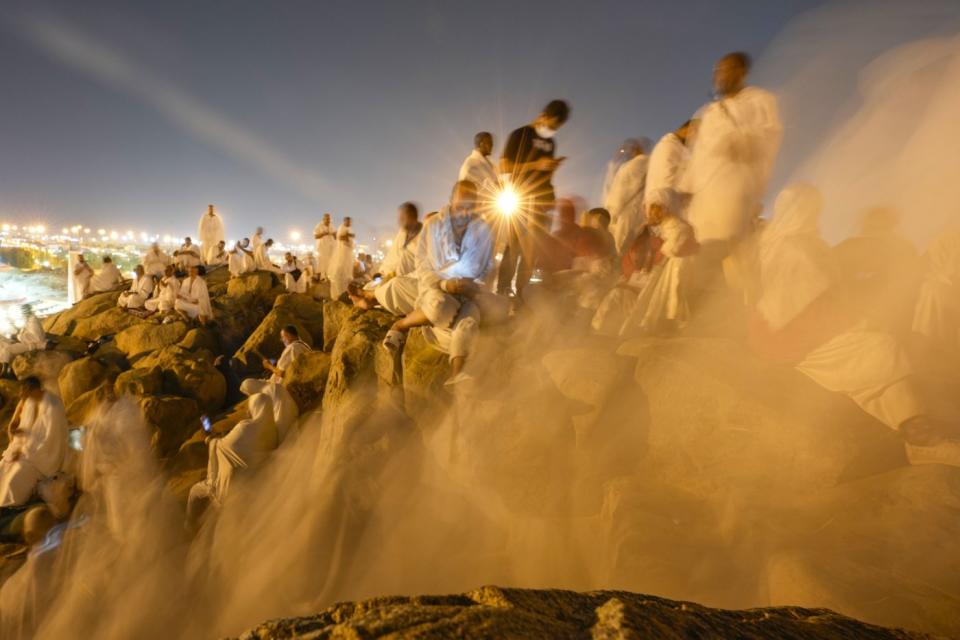Muslim pilgrims wrap up the Hajj with final symbolic stoning of the devil and circling of the Kaaba
MINA, Saudi Arabia (AP) — Muslim pilgrims wrapped up the Hajj in the deadly summer heat on Tuesday with the third day of the symbolic stoning of the devil, and the last circumambulation around the Kaaba, Islam's holiest site, in the city of Mecca.
The three-day stoning ritual in Mina, a desert site outside Mecca, is among the final rites of the pilgrimage and symbolizes the casting away of evil and sin. It started a day after pilgrims congregated on Saturday at a sacred hill known as Mount Arafat.
The final days of the annual Hajj coincide with Muslims around the world celebrating the Eid al-Adha holiday when the faithful with financial means commemorate Prophet Ibrahim’s test of faith, when God ordered him to sacrifice his only son, by slaughtering livestock and animals and distributing the meat to the poor.
The Hajj is one of the five pillars of Islam. Its rituals largely commemorate the accounts of Prophet Ibrahim and his son Prophet Ismail, Ismail’s mother Hajar and the Prophet Muhammad, according to the Quran, Islam’s holy book. In the Islamic version, God stayed his hand and Ismail was spared.
“I am reassured. I feel comfortable,” Mejahed al-Mehrabi, a Yemeni pilgrim, told The Associated Press after he was done with the third day of the stoning ritual. “Anyone who can visit the Grand Mosque (in Mecca) should do so.”
Nigerian pilgrim Amir Omar was overjoyed once he finished his symbolic stoning. “I am feeling very great that I perform one pillar of my religion,” he said. “I am feeling very grateful.”
The burning sun and suffocating hot weather were relentless on Tuesday, with temperatures expected to reach 47 degrees Celsius (117 degrees Fahrenheit) in Mecca and the sacred sites in and around the city, according to the Saudi National Center for Metrology.
Many pilgrims, particularly elderly ones, collapsed and required medical assistance because of the heat. Dozens were also reported to have died from sunstroke.
The fatalities among pilgrims included at least 41 Jordanians and 35 Tunisians, according to Jordanian and Tunisian authorities. Local media in Egypt also reported dozens of fatalities among Egyptian pilgrims. Saudi authorities have yet to provide death tally during this year's Hajj.
Many other pilgrims couldn't be accounted for while performing the rituals. Many Egyptians took to social medial to search for their relatives they believed were in Mount Arafat and in Mina. Some were found in hospitals around Mecca, after collapsing from the heat.
After the third symbolic stoning Tuesday, pilgrims headed to Mecca to perform “tawaf,” the circling the Kaaba in the Grand Mosque counterclockwise seven times. That circumambulation, known as the Farewell Tawaf, marks the end of Hajj as pilgrims prepare to leave the holy city.
Once the Hajj is over, men are expected to shave their heads, and women to snip a lock of hair in a sign of renewal.
Most of the pilgrims then leave Mecca for the city of Medina, about 340 kilometers (210 miles) away, to pray in the Prophet Muhammad’s tomb, the Sacred Chamber.
The Sacred Chamber is part of the prophet’s mosque, one of the three holiest sites in Islam, along with the Grand Mosque in Mecca and Al Aqsa Mosque in Jerusalem.
All Muslims are required to make the Hajj once in their lives if they are physically and financially able to do so. Many wealthy Muslims make the pilgrimage more than once.
More than 1.83 million Muslims performed the Hajj in 2024, including more than 1.6 million pilgrims from 22 countries, and around 222,000 Saudi citizens and residents, according to the Saudi Hajj authorities.
The 2024 pilgrimage came against the backdrop of the devastating Israel-Hamas war, which has pushed the Middle East to the brink of a regional conflict.
“I prayed first for Gaza then Yemen,” said al-Mehrabi, the Yemeni pilgrim, referring to the war in the Palestinian enclave and the decade-old conflict in his home country.
___
Associated Press religion coverage receives support through the AP’s collaboration with The Conversation US, with funding from Lilly Endowment Inc. The AP is solely responsible for this content.
Samy Magdy, The Associated Press



